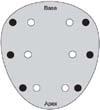Abstract
Purpose
We evaluated the rate of prostate cancer detection according to the region and number of biopsies in patients with an elevated level of serum prostate-specific antigen (PSA).
Materials and Methods
Transrectal ultrasound (TRUS) guided prostate biopsies were performed at 12 regions, using the standard sextant, with an additional 6 cores from the far lateral peripheral zone, in 178 men with an elevated PSA level, and with no suspicious lesions of prostate cancer on digital rectal examination (DRE) and TRUS. We analyzed the rate prostate cancer detection according to the region, number of biopsies, the PSA level, prostate volume and PSA density (PSAD).
Results
The rates of cancer detection were 12.9, 11.8 and 7.4% in the 12 core, lateral 6 core and medial 6 core (standard sextant) biopsies, respectively (p<0.05). There were no differences in overall cancer detection rates between 12 core and lateral 6 core plus apex medial 2 core biopsies (12.9%). In men with a PSA level greater than 20ng/ml, no difference in cancer detection was found with the 12 core or either of the 6 core biopsies (positive rate 33.3%). In men with a PSA level over 10ng/ml, a prostate volume less than 49cc or a PSAD greater than 0.15, a lateral 6 core biopsy made no difference to the diagnosis of prostate cancer compared to a 12 core biopsy.
Figures and Tables
Fig. 1
The coronal prostate plane, showing the 12 core biopsy scheme. Open and closed circles represent standard and lateral sextant sites, respectively.

References
1. Hodge KK, McNeal JE, Terris MK, Stamey TA. Random systematic versus directed ultrasound guided transrectal core biopsies of the prostate. J Urol. 1989. 142:71–74.
2. Cookson MS. Update on transrectal ultrasound-guided needle biopsy of the prostate. Mol Urol. 2000. 4:93–97.
3. Uzzo RG, Wei JT, Waldbaum RS, Perlmutter AP, Byrne JC, Vaughan ED Jr. The influence of prostate size on cancer detection. Urology. 1995. 46:831–836.
4. Park YS, Kwak C, Shim HB. Effect of prostate size on cancer detection rate of traditional sextant prostate biopsy. Korean J Urol. 2003. 44:1098–1102.
5. Stamey TA. Making the most of six systematic sextant biopsies. Urology. 1995. 45:2–12.
6. Terris MK, Wallen EM, Stamey TA. Comparison of mid-lobe versus lateral systematic sextant biopsies in the detection of prostate cancer. Urol Int. 1997. 59:239–242.
7. Lee SB, Kim CS, Ahn HJ. Comparative analysis of sextant and extended prostate biopsy. Korean J Urol. 2004. 45:524–529.
8. Presti JC Jr, Chang JJ, Bhargava V, Shinohara K. The optimal systematic prostate biopsy scheme should include 8 rather than 6 biopsies: results of a prospective clinical trial. J Urol. 2000. 163:163–166.
9. Moon KH, Cheon SH, Kim CS. Systematic 10-site prostate biopsy is superior to sextant method for diagnosing carcinoma of the prostate. Korean J Urol. 2000. 41:1178–1182.
10. Durkan GC, Sheikh N, Johnson P, Hildreth AJ, Greene DR. Improving prostate cancer detection with an extended-core transrectal ultrasonography-guided prostate biopsy protocol. BJU Int. 2002. 89:33–39.
11. Ravery V, Goldblatt L, Royer B, Blanc E, Toublanc M, Boccon-Gibod L. Extensive biopsy protocol improves the detection rate of prostate cancer. J Urol. 2000. 164:393–396.
12. Park HK, Byun SS, Sohn DW, Hong SK, Lee ES, Lee ES. The efficacy of 12-site biopsy protocol in men with elevated serum prostate specific antigen level only. Korean J Urol. 2005. 46:463–466.
13. Borboroglu PG, Comer SW, Riffenburgh RH, Amling CL. Extensive repeat transrectal ultrasound guided prostate biopsy in patients with previous benign sextant biopsies. J Urol. 2000. 163:158–162.
14. Babaian RJ, Toi A, Kamoi K, Troncoso P, Sweet J, Evans R, et al. A comparative analysis of sextant and an extended 11-core multisite directed biopsy strategy. J Urol. 2000. 163:152–157.
15. de la Taille A, Antiphon P, Salomon L, Cherfan M, Porcher R, Hoznek A, et al. Prospective evaluation of a 21-sample needle biopsy procedure designed to improve the prostate cancer detection rate. Urology. 2003. 61:1181–1186.
16. Bae KS, Chang SG. Comparative analysis between sextant biopsy and 12-samples needle biopsy for detection of stage T1c prostate cancer. Korean J Urol. 2004. 45:653–657.
17. Eskew LA, Bare RL, McCullough DL. Systematic 5 region prostate biopsy is superior to sextant method for diagnosing carcinoma of the prostate. J Urol. 1997. 157:199–202.
18. Karakiewicz PI, Bazinet M, Aprikian AG, Trudel C, Aronson S, Nachabe M, et al. Outcome of sextant biopsy according to gland volume. Urology. 1997. 49:55–59.
19. Jung JY, Jeong H, Chung JS, Lee SB, Lee SE. The outcome of TRUS-guided sextant biopsy according to prostate volume. Korean J Urol. 2000. 41:505–511.




 PDF
PDF ePub
ePub Citation
Citation Print
Print






 XML Download
XML Download